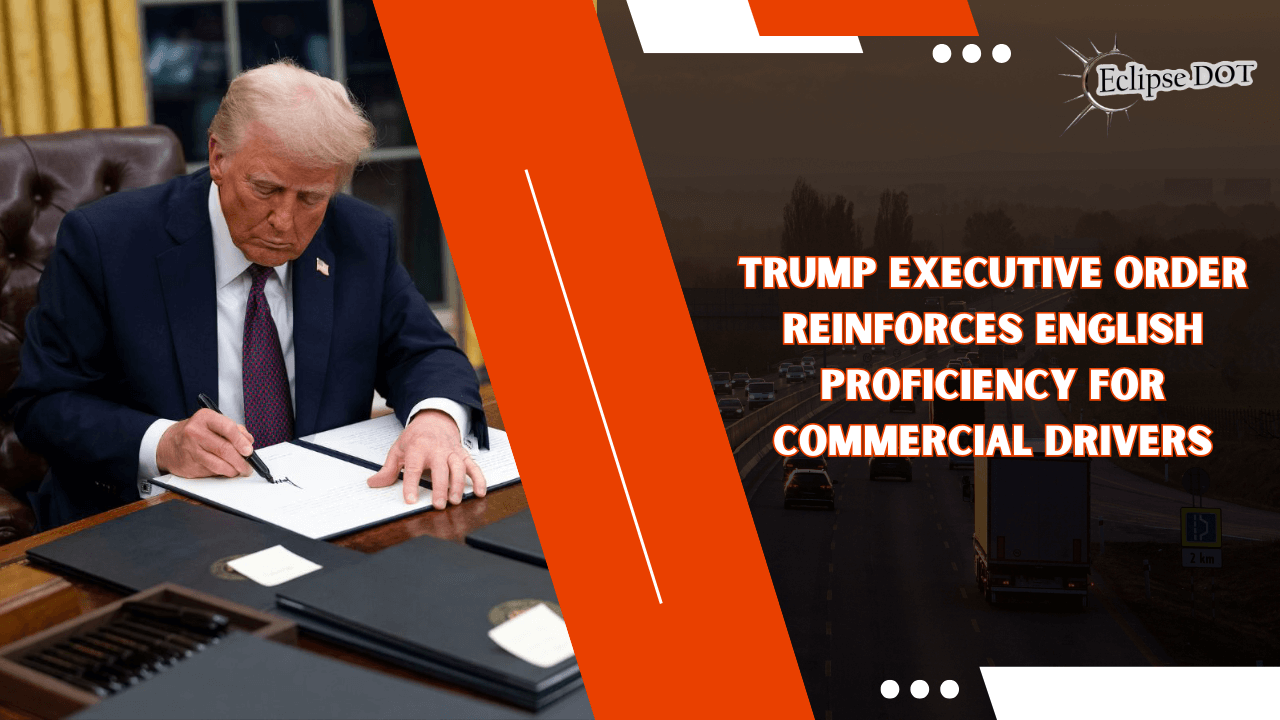If you’re gonna drive a big rig in the U.S., you better be able to read the dang road signs. That’s the message coming straight from Washington this week, as President Donald Trump signed an executive order that’s shaking up the trucking world — again.
On April 28, 2025, Trump signed an executive order putting some serious teeth back into an old rule: Commercial drivers must speak English. Not kinda-sorta. Not “I know enough to get by.” We’re talking full-on road-ready English — the kind that keeps freight moving, roads safe, and inspections smooth.
This move isn’t about adding new laws. It’s about enforcing the ones that have been gathering dust on the shelf. The federal rule’s been there for years, but according to the Trump administration (and frankly, a whole lot of people in the industry), it hasn’t been enforced like it should.
So now? The gloves are off.
🔧 The Order, Broken Down Like a Service Manual
Let’s cut through the political fluff and break down what this actually means for drivers, fleets, and anyone responsible for DOT compliance:
1. Tossing the 2016 Softball Guidance
Back in 2016, the feds issued some guidance that basically told inspectors, “Hey, don’t worry too much if the driver can’t fully communicate in English.” That’s like saying, “Don’t worry if the brakes are kinda soft.” Trump just called B.S. on that. The order instructs Secretary of Transportation Sean Duffy to shred that memo and bring back real accountability.
2. Out-of-Service Means Out of Service
This ain’t a warning or a slap on the wrist. If a driver can’t communicate in English well enough to answer questions, read road signs, or handle a safety inspection — they’re getting parked. On the spot.
3. Cracking Down on Non-Domiciled Licenses
DOT’s being told to check how states are handing out CDLs to folks who don’t live in the U.S. permanently. Translation: if someone’s sliding through the cracks and hitting the road with paperwork that doesn’t hold water, it’s about to get caught.
4. Bonus Round — Better Working Conditions for Truckers
It’s not just about stricter rules. The order also tells DOT to improve driver working conditions. Yeah, you read that right. The same order that tightens the language belt also says truckers deserve better — more support, safer hours, fairer treatment.
📜 Let’s Be Clear — This Isn’t New Law
The law requiring English proficiency has been on the books forever. Seriously — 49 CFR § 391.11(b)(2) is not some hidden clause in the fine print. It straight-up says that if you’re driving a CMV, you need to read and speak English well enough to:
-
Converse with the general public
-
Understand highway traffic signs
-
Respond to official inquiries
-
Fill out reports and logs
It’s just that for a while, enforcement turned into more of a suggestion than a standard. Different states applied it differently. Some inspectors gave passes. Others didn’t. Confusion set in. Accidents happened. People started asking, “Why do we even have this rule if no one enforces it?”
Trump’s answer? “We do now.”
🚛 Industry Response: Cheers from the Cab
This isn’t one of those executive orders that left everyone scrambling. Quite the opposite. Major voices in trucking practically shouted “Finally!” from their dispatch decks.
American Trucking Associations (ATA)
Dan Horvath, ATA’s Senior VP of Regulatory and Safety Policy, was quick to issue a thank-you note (well, probably an email) to the White House:
“We thank the Trump Administration for responding to our concerns. We’re ready to help create a standard that’s fair, consistent, and actually works.”
Translation: it’s about dang time.
Chris Spear, ATA’s President, also sent a letter earlier this year asking DOT to fix the enforcement mess. Looks like someone listened.
Owner-Operator Independent Drivers Association (OOIDA)
You know who else had something to say? OOIDA, the watchdogs for the little guys — the owner-operators who run lean and don’t play around.
President Todd Spencer said it loud and clear:
“Basic English skills are essential. Road signs save lives—but only when they’re understood.”
And he’s right. Nobody wants to be behind a rig when the driver can’t read “Bridge Out Ahead.” That’s not a language issue. That’s a safety time bomb.
🧠 Why This Actually Matters — In Real Life
Let’s get real here. This isn’t about politics. This is about highway safety.
Imagine this: It’s 3:00 a.m. You’re rolling through New Mexico with a full load. Flashing lights. DOT waves you over. The officer gives instructions, asks for your logs, and throws a curveball question about your last stop. If that driver doesn’t understand or can’t reply?
That inspection just turned into a guessing game. A dangerous one.
Worse? What if they miss a “Dangerous Curve Ahead” sign? Or misunderstand directions at an agricultural checkpoint?
Language isn’t just a formality — it’s part of the safety system. And if you can’t understand the system, you shouldn’t be behind the wheel.
📊 Stats Don’t Lie
Still not convinced? Let’s bring in the numbers.
According to FMCSA reports, over 30,000 roadside inspections per year include communication-related issues. In some states, inspectors admit they “let it slide” if a driver can’t speak fluent English but “seems safe.”
That’s not a system. That’s a gamble.
Meanwhile, OOIDA’s own data shows that when English proficiency is enforced fairly and clearly, safety violations drop. Why? Because drivers know what to expect — and carriers are more careful about who they hire.
This isn’t just theory. It’s results.
⚠️ The Pushback: Not Everyone’s Throwing Confetti
Of course, not everyone is cheering.
The Sikh Coalition raised serious concerns — and they’re not wrong to be watching closely.
Sikh truckers are a huge part of the U.S. freight network. According to Deccan Herald, over 150,000 Sikhs work in transportation, with 90% of them driving trucks. They keep this country moving — plain and simple.
The Coalition fears this rule could be used to discriminate against Sikh or immigrant drivers who speak English, but maybe speak it differently — or with an accent.
And let’s be honest: that can happen. That’s why enforcement has to be based on function, not appearance. Can the driver communicate clearly during an inspection? Can they read a sign and follow a command? If yes, they’re good. If no, they’re parked — regardless of their last name, headwear, or home language.
It’s up to DOT and enforcement agencies to make sure the rule gets enforced fairly. And we should all hold them to that.
🗺️ The States Were Already Moving This Direction
This federal order didn’t just appear out of thin air. Several states were already tired of the inconsistency and decided to take the wheel.
-
Arkansas passed its own English requirement earlier this year.
-
Oklahoma is in the process of reviewing legislation.
-
And a Wyoming congressman called out DOT just a few weeks ago, demanding they clean up the 2016 mess.
So when this executive order dropped, it wasn’t a surprise — it was a green light for change.
🧭 What You Should Be Doing Right Now
If you’re reading this as a fleet owner, safety manager, HR director, or even a one-man trucking operation — listen up. This is not the time to wait for the FMCSA to knock on your door.
Here’s what you can do today:
✅ Review Your Hiring Standards
Make sure every driver you hire meets the English requirement. Interview them. Ask questions. Don’t assume.
✅ Train Your Trainers
Your safety and orientation staff need to know what the standard is — and how to explain it without bias.
✅ Offer Language Support
Got great drivers who just need a little help? Set them up for success. Provide language training tools or point them to resources. Don’t throw them out — lift them up.
✅ Prep for More Inspections
Expect inspectors to test for English comprehension more often — especially at the roadside. Be ready for it.
🗣️ Dan Greer’s Two Cents
Look, I’ve spent enough time in yards, weigh stations, and courtrooms to know this: when a rule goes unenforced, confusion takes over — and in trucking, confusion can kill.
I’m not here to get political. I’m here to help you stay compliant and keep your people safe. This executive order? It’s not about who’s in the White House. It’s about who’s behind the wheel.
If your company doesn’t have a handle on this, we need to talk.
🔍 Want Help Navigating This?
At Eclipse DOT, we make rules like this one easy to understand — and even easier to comply with. We don’t do guesswork. We do audits, training, and real-world strategy that protects your people and your bottom line.
Gain exclusive access to our CDL & DOT Compliance articles with a trial at DOTDocs.com. And don’t forget to claim your FREE micro audit at THE ECLIPSE DOT MICRO AUDIT. Ready for seamless operations? Discover the difference today!


